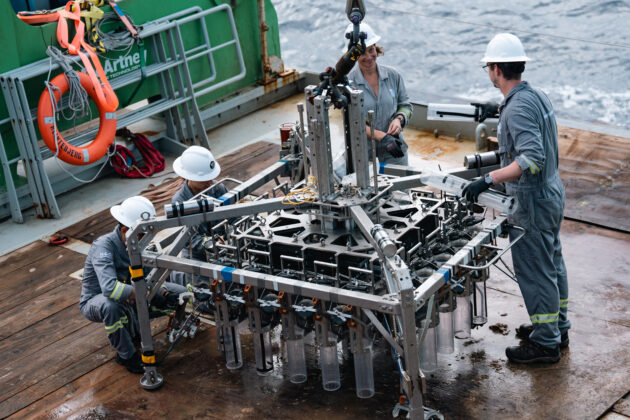
TMC’s subsidiary NORI completes offshore research campaign
by CM Staff
Using a remotely operated vehicle (ROV), the research team deployed seafloor lander systems that are capable of measuring seafloor oxygen fluxes using eddy covariance methods.

Researchers prepare to launch a multicore sampler which is used to assess the biological and chemical properties of the sediment on the seafloor. As part of its latest campaign, NORI conducted extensive sampling in the test mining area and in areas influenced by the sediment plume.
NEW YORK — The Metals Company, an explorer of lower-impact battery metals from seafloor polymetallic nodules, announced the conclusion of its latest offshore scientific research campaign to assess seafloor impacts and recovery rates twelve months after the pilot nodule collection system test conducted by its NORI subsidiary.
Despite disruptions from Greenpeace International aimed at hindering the collection of key environmental data requested by the ISA’s Legal and Technical Commission, researchers were able to complete the major components of the scientific work scope slated for the campaign. The data gathered will further support NORI’s application to the International Seabed Authority for a commercial exploitation contract, which it expects to submit following the July 2024 meeting of the ISA.
The team selected 19 sampling stations in the locality of last year’s nodule collection system test and conducted 39 multicore deployments, recovering 395 individual core samples. These yielded more than 600 subsamples that will be shared with independent researchers from leading marine research institutions for further biological analysis.
Additionally, using a remotely operated vehicle (ROV), the research team deployed seafloor lander systems that are capable of measuring seafloor oxygen fluxes using eddy covariance methods.
Dr Michael Clarke, TMC’s Environmental Manager, said: “Despite attempts to disrupt our offshore scientific program the data collected is more than sufficient to meet our objectives for the campaign. This new information provides an insight as to the scale of seabed disturbance from nodule collection and how the benthic communities respond over time. Using the data collected during our decade-long research program, we can now conduct a robust, data-driven assessment of the impacts of nodule collection on the marine environment. We look forward to presenting the findings of our studies to the ISA and stakeholders in the coming year.”
Using the ROV, the team gathered over 30 hours of dedicated video footage of the seafloor, with particular focus on sessile organisms. Based upon a preliminary qualitative assessment, organisms identified during NORI’s environmental baseline studies are still present twelve months on in areas that have been influenced by the seafloor plume. This data will be shared with researchers for further analysis.
Researchers also conducted the fourth annual recovery and redeployment of three oceanographic moorings within NORI-D. The sensor payload on the moorings provides insights into the soundscape, regional oceanographic currents, and particulate organic carbon flux in the Eastern CCZ region. This data contributes to the long-term oceanographic time series and importantly will cover the El Niño-Southern Oscillation fluctuations.